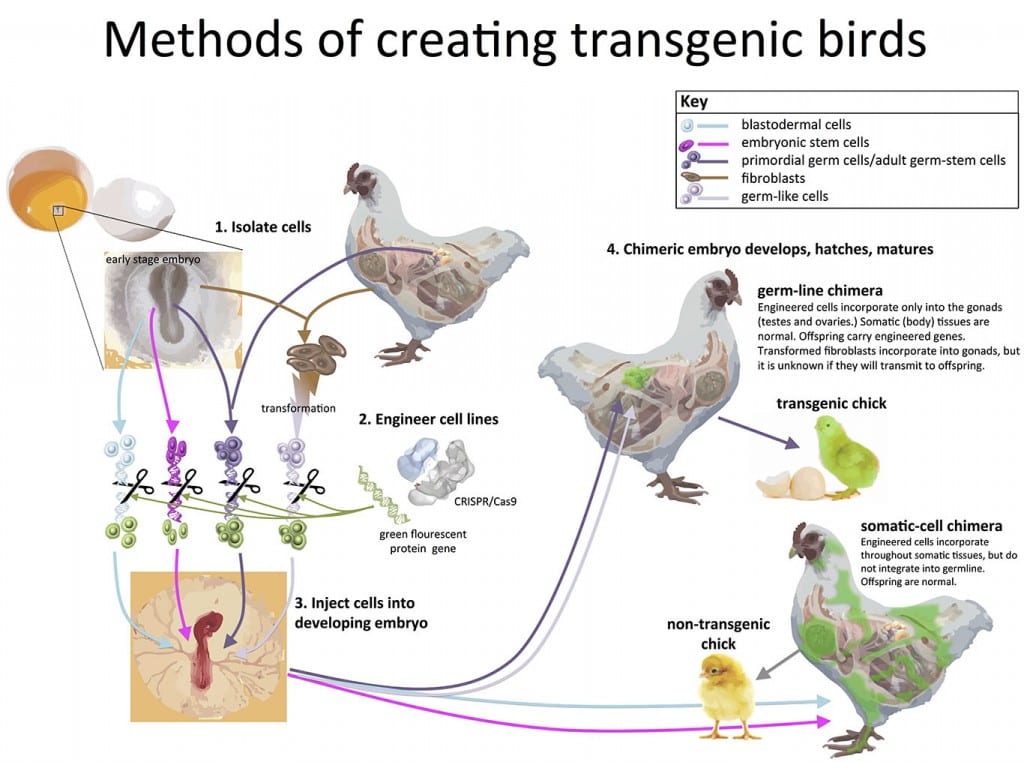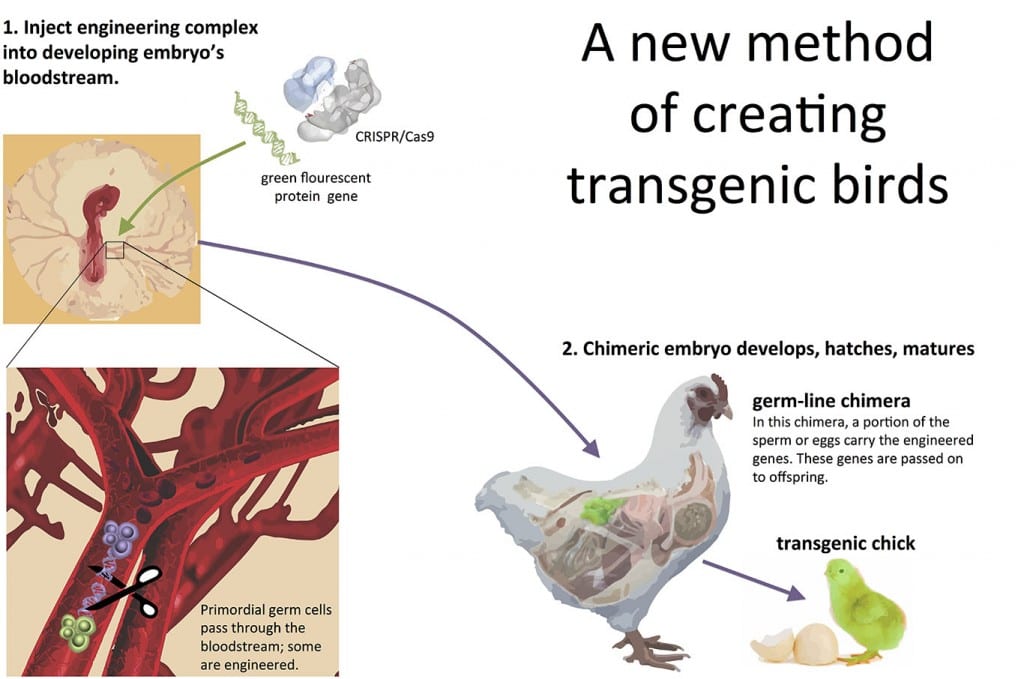A follow up to “Why birds are a challenge”
by Ben J. Novak

The next phase of The Great Passenger Pigeon Comeback is approaching: the engineering of passenger pigeon mutations into living pigeons. The first requirement to do this is a flock of pigeons; the second is a viable method to creating engineered birds. Engineering birds is not difficult, but making engineered birds that are capable of passing on their engineered traits is a formidable challenge in the world of avian research. The key element in viability is that the passenger pigeon mutations we edit are incorporated into the germ cells – sperm and eggs (oocytes) – so that the engineered passenger pigeons can breed.
The many methods that could be used were critiqued early on in project discussions among our advisors. They included cloning (somatic cell nuclear transfer, accomplished in many placental mammals), stem cell gametogenesis (has been done in mice), direct engineering of early stage embryos (has been done in several mammals), embryonic stem cell editing, and primordial germ cell (PGC) editing. A lot of ideas were shelved because they simply couldn’t scale up to the needs of de-extinction.
Editing embryonic stem cells was concluded to be a non-viable route, as these cells lose the ability to become germ cells when in culture. Engineering early embryos was mentioned as a plausible route, but unless many genome edits can be done at once our project’s timeline is left at the mercy of the birds’ natural life cycle. In other words, we would have to wait for our engineered birds to grow up and breed every time we wanted to introduce new passenger pigeon genes. Pigeons sexually mature at about eight months old – engineering 10 passenger pigeon genes this way, one at a time, would take nearly seven years if we had 100% efficiency. We might be editing hundreds to thousands of genes….
However, since those early discussions in the project avian research has been making advances. While cloning has been deemed virtually impossible for many reasons, a team of researchers based at Texas A&M University were able to successfully complete the first step towards cloning: the removal of the egg cell’s nucleus (enucleation)1. This had been impossible in the past because, unlike mammalian egg cells which are tiny and transclucent, a bird’s egg cell is filled with opaque yolk and it is huge – this means that finding the nucleus is like looking for a white marble in a pool of milk. The team’s work, published in 2014, used staining and epiflourescence to find the nucleus in chicken egg cells and then successfully removed it without damaging the egg cell’s membrane.
The next steps in cloning would be to 1) insert a donor nucleus of a new bird into the enucleated egg cell, 2) stimulate embryonic growth, and 3) implant the embryo into a mother bird or egg . Steps 1 and 2 might work out well in the laboratory, but step 3 poses a huge challenge given the reproductive tract of birds. But, if researchers keep working on it we may see the world’s first cloned bird in our lifetime – though, it’s unlikely this method will be applicable in the short term for de-extinction.
Stem cell gametogenesis – creating germ cells from stem cells – was shelved because developments in birds were lacking. In mice, induced pluripotent stem cells created from fibroblasts have been reprogrammed to develop into both sperm and egg cells and have yielded healthy offspring. Chicken iPSC’s can be created, but are limited in their ability to develop into multiple tissue types. If fibroblasts could be used to create baby birds then the world of bird de-extinction would open up expansively, and the frozen fibroblast cell lines of endangered bird species at the San Diego Frozen Zoo could be used to rescue species on the verge of extinction. Yangqing et al recently had success in pursuing this pathway – turning chicken fibroblasts into “germ-like” cells in the same way that induced pluripotent stem cells are made2. These induced, germ-like cells were injected into chicken embryos and migrated to the gonads – though colonizing the gonads is only the first step in success. Many times in bird research injected cells will incorporate into the gonads (testes or ovaries) but will not integrate and develop into adult germ cells. The bird created can carry introduced cells, but not pass them on to offspring.
These are exciting advancements, but the most viable method remains in vitro primordial germ cell engineering – making genome edits in germ cells in a “petri dish”. By growing primordial germ cells in culture researchers can make genome edits sequentially without being restricted by the breeding cycle of living birds, and the cultured cells will contribute to the germ line when injected into new embryos. This is the route our project is pursuing, but it may take several years to establish a cultured cell line; bird primordial germ cells are quite finicky about living outside of a bird’s body. A further complication is that transferring cultured primordial germ cells into a bird requires same sex transfer – female birds cannot receive primordial germ cells harvested from a male embryo and vice versa. To begin passenger pigeon de-extinction we need the successful establishment of both a male and female primordial germ cell cell line. To date working with female primordial germ cells and female transfer has yielded lower efficiency rates than working with male lines.
Our team would like to be able to research passenger pigeon genes for de-extinction while primordial germ cell cultures are developed, and an Australian team has developed an effective way of bypassing cell cultures for engineering birds by going directly to the primordial germ cells in the embryo. The team has shown that new genes can be injected into the blood stream of a developing embryo. As the primordial germ cells migrate through the blood from the germinal crescent to the gonads they pick up the new genes. When the bird hatches it carries a small percentage of germ cells that carry the new genes. This method could have major benefits to de-extinction, but more so excitingly it could have huge implications for endangered species that have lost genetic diversity or are immunocompromised, as it offers a way to edit lost genes and antibody genes directly into developing birds. Instead of needing to spend years developing cultured cells, the foundation to this work is breeding birds in captivity – something already up and running for many of the world’s rarest birds (e.g. Kakapo, Attwater’s Prairie Chicken, various Hawaiian honeycreepers).
The disadvantage: this method is subject to the life cycle of the birds in the same way as direct embryo editing (mentioned above). However, we may be able to introduce multiple gene edits at once with CRISPR/Cas9 – something that was incredibly limited with previous genome editing technologies.
 This method could prove a viable route of studying the effects of passenger pigeon mutations on bird traits – a means to discovering how to fine-tune the passenger pigeon de-extinction process. One could develop a breeding flock of band-tailed pigeons, or even rock pigeons that carry germ cells containing multiple passenger pigeon mutations in different combinations. When interbreeding these birds, we would be able to study the interaction of different passenger pigeon genes. This method has one great advantage – it can be done to both female and male embryos alike. It is unlikely that we can use this method to edit large sections of DNA (10,000 base pair regions), but single mutations we could have great success. To do de-extinction successfully we need the power to engineer large sections of DNA sequentially in a period of weeks/months rather than years, so primordial germ cells cell cultures will be the mainstay of our effort, but while we wait we could establish a stock of birds that have a few passenger pigeon mutations as a foundation. Discussions about if whether we can and if so how to incorporate this work into our project are underway.
This method could prove a viable route of studying the effects of passenger pigeon mutations on bird traits – a means to discovering how to fine-tune the passenger pigeon de-extinction process. One could develop a breeding flock of band-tailed pigeons, or even rock pigeons that carry germ cells containing multiple passenger pigeon mutations in different combinations. When interbreeding these birds, we would be able to study the interaction of different passenger pigeon genes. This method has one great advantage – it can be done to both female and male embryos alike. It is unlikely that we can use this method to edit large sections of DNA (10,000 base pair regions), but single mutations we could have great success. To do de-extinction successfully we need the power to engineer large sections of DNA sequentially in a period of weeks/months rather than years, so primordial germ cells cell cultures will be the mainstay of our effort, but while we wait we could establish a stock of birds that have a few passenger pigeon mutations as a foundation. Discussions about if whether we can and if so how to incorporate this work into our project are underway.
In the example figures we show the use of CRISPR/Cas9, but to date no transgenic birds produced using CRISPR/Cas9 technology have been published, though several teams are working with the technology now. Many other types of biotech have been used to create transgenic birds. For those of you wanting to delve deeper into the world of bird transgenics a new review paper is publicly available on the status and history of germ cells and their uses.
1. Kjelland M.E., Romo S., Kraemer D.C. 2014. Avian cloning: adaptation of a technique for enucleation of the avian ovum. Avian Biology Research 7(3):131-138
2. Yangqing L., et al. 2014. Induced pluripotency in chicken embryonic fibroblast results in a germ cell fate. Stem Cells and Development 23(15):1755-1764
3. Tyack S.G., et al. 2013. A new method for producing transenic birds via direct in vivo transfection of primordial germ cells. Transgenic Research 22(6):1257-1264
4. Han J.Y., Lee H.C., Park T.S. 2015. Germline-competent stem cell in avian species and its application. Asian J Androl 17(3):421-6.



